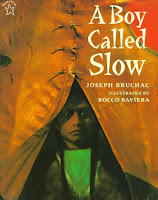
By Patricia MacLachlan
This is probably my second favorite book by Patricia MacLachlan. Throughout her books I get a sense that she views her pets as great companions who have very human like qualities. This book definitely portrays that, as a dog and a cat of a family discover the new born baby, Bittle. At first they do not like her and are afraid to be around her. With time, and after she shares her food with both of them, they realize that they in fact love Bittle. They are then very protective of her. I think this is a very true story in that pets react very similarly to a new baby in the family. I also think that the author probably did not make this story up completely because during the A/P/I study I could tell that she uses real life experiences for her books. The illustrations were very cute and appropriate for the story; Bittle a little girl with a few tufts of hair and a dress on, a large dog named Julia, and a curious cat named Nigel. Overall, a very cute story!

















































